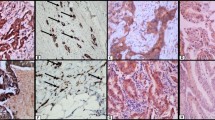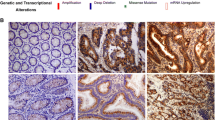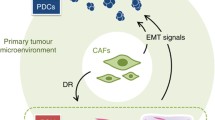Abstract
Epithelial–mesenchymal transition (EMT) plays an important role in cancer metastasis. During EMT, tumor cells acquire the capacity to migrate and invade the stroma. Activation of the transforming growth factor-b (TGF-b) signaling pathway is of major importance for the initiation of EMT. Smad4, an essential protein of this pathway, is known to complex with multiple transcription factors (e.g. Snail-1, Slug, Twist-1), in various types of cancer, promoting the repression or activation of target genes. The role of Smad4 in colorectal cancer (CRC) is not straightforward so far. In the present study forty eight resected CRC tumor specimens were immunohistochemically examined in order to assess the expression of Smad4 and its association with E-cadherin, Snail-1, Slug, Twist-1 protein expression and with various pathological parameters. Smad4 was found to be positively correlated with Snail-1, Slug and Twist-1 expression (p < 0.001). On the other hand it was negatively correlated with the expression of E-cadherin (p < 0.001). Furthermore, lymphatic invasion could be clearly associated with Smad4 expression, a finding complying with the metastatic ability of EMT cells. In conclusion, Smad4 could be considered as a central component of EMT transition in human colorectal cancer that combines with transcriptional factors to reduce E-cadherin and alter the expression of the epithelial phenotype.





Similar content being viewed by others
References
Alexander NR, Tran NL, Rekapally H, Summers CE, Glackin C, Heimark RL (2009) N-cadherin gene expression in prostate carcinoma is modulated by integrin-dependent nuclear translocation of Twist1. Cancer Res 66(7):3365–3369
Beltran M, Puig I, Peña C, García JM, Alvarez AB, Peña R, Bonilla F, de Herreros AG (2008) A natural antisense transcript regulates Zeb2/Sip1 gene expression during Snail1-induced epithelial–mesenchymal transition. Genes Dev 2008 22(6):756–769
Birchmeier W, Behrens J (1994) Cadherin expression in carcinomas: role in the formation of cell junctions and the prevention of invasiveness. Biochim Biophys Acta 1198(1):11–26
Brabletz T, Hlubek F, Spaderna S, Schmalhofer O, Hiendlmeyer E, Jung A, Kirchner T (2005) Invasion and metastasis in colorectal cancer: epithelial–mesenchymal transition, mesenchymalepithelial transition, stem cells and β-catenin. Cells Tissues Organs 179:56–65
Casas E, Kim J, Bendesky A, Ohno-Machado L, Wolfe CJ, Yang J (2011) Snail2 is an essential mediator of Twist1-induced epithelial mesenchymal transition and metastasis. Cancer Res 71(1):245–254
Chen ZF, Behringer RR (1995) Twist is required in head mesenchyme for cranial neural tube morphogenesis. Genes Dev 9:686–699
Cheng GZ, Chan J, Wang Q, Zhang W, Sun CD, Wang LH (2007) Twist transcriptionally up-regulates AKT2 in breast cancer cells leading to increased migration, invasion, and resistance to paclitaxel. Cancer Res 67(5):1979–1987
Dave N, Guaita-Esteruelas S, Gutarra S, Frias A, Beltran M, Peiro S, de Herreros AG (2011) Functional cooperation between Snail1 and twist in the regulation of ZEB1 expression during epithelial to mesenchymal transition. J Biol Chem 286(14):12024–12032
De Bosscher K, Hill CS, Nicolás FJ (2004) Molecular and functional consequences of Smad4 C-terminal missense mutations in colorectal tumour cells. Biochem J 379(Pt 1):209–216
Deckers M, van Dinther M, Buijs J, Que I, Ladwik C, van der Pluijm G, ten Dijke P (2006) The tumor suppressor SMAD4 is required for transforming growth factor beta-induced epithelial to mesenchymal transition and bone metastasis of breast cancer cells. Cancer Res 66:2202–2209
Ding Z, Xu F, Tang J, Li G, Jiang P, Tang Z, Wu H (2016) Physcion 8-O-β-glucopyranoside prevents hypoxia-induced epithelialmesenchymal transition in colorectal cancer HCT116 cells by modulating EMMPRIN. Neoplasma 63:351–361
Fan F, Samuel S, Evans KW, Lu J, Xia L et al (2012) Overexpression of snail induces epithelial-mesenchymal transition and a cancer stem cell-like phenotype in human colorectal cancer cells. Cancer Med 1(1):5–16
Franco HL, Casanovas J, Rodrı´guez-Medina JR, Cadilla CL (2011) Redundant or separate entities? Roles of Twist1 and EMT-activating transcription factors and cancer Twist2 as molecular switches during gene transcription. Nucleic Acids Res 39(4):1177–1186
Fuxe J, Vincent T, Garcia de Herreros A (2010) Transcriptional crosstalk between TGF-β and stem cell pathways in tumor cell invasion: role of EMT promoting Smad complexes. Cell Cycle 9(12):2363–2374
Geiger TR, Peeper DS (2009) Metastasis mechanisms. Biochim Biophys Acta 1796:293–308
Gill S, Thomas RR, Goldberg RM (2003) Colorectal cancer chemotherapy. Aliment Pharmacol Ther 18:683–692
Grunert S, Jechlinger M, Beug H (2003) Diverse cellular and molecular mechanisms contribute to epithelial plasticity and metastasis. Nature Rev 4:657–665
Guarino M (2007) Epithelial–mesenchymal transition and tumour invasion. Int J Biochem Cell Biol 39:2153–2160
Gumbiner BM (2005) Regulation of cadherin-mediated adhesion in morphogenesis. Nat Rev Mol Cell Biol 6:622–634
Gurzu S, Turdean S, Kovecsi A, Contac AO, Jung I (2015) Epithelial mesenchymal, mesenchymal-epithelial, and endothelialmesenchymal transitions in malignant tumors: An update. World J Clin Cases 3:393–404
Hao L, Zhao Y, Wang Z, Yin H, Zhang X, He T, Song S, Sun S, Wang B, Li Z, Su Q (2016) Expression and clinical significance of SALL4 and β-catenin in colorectal cancer. J Mol Histol 47(2):117–128
Hay ED (1995) An overview of epithelio-mesenchymal transformation. Acta Anat (Basel) 154:8–20
Joseph MJ, Dangi-Garimella S, Shields MA, Diamond ME, Sun L, Koblinski JE et al (2009) Slug is a downstream mediator of transforming growth factor-beta1-induced matrix metalloproteinase-9 expression and invasion of oral cancer cells. J Cell Biochem 108:726–736
Kalluri R, Weinberg RA (2009) The basics of epithelial-mesenchymal transition. J Clin Invest 119:1420–1428
Karamitopoulou E (2013) Tumor budding cells, cancer stem cells and epithelial-mesenchymal transition-type cells in pancreatic cancer. Front Oncol 209(2):1–5
Karhadkar SS, Bova GS, Abdallah N, Dhara S, Gardner D, Maitra A et al (2004) Hedgehog signalling in prostate regeneration, neoplasia and metastasis. Nature 431:707–712
Kim YH, Kim G, Kwon CI, Kim JW, Park PW, Hahm KB (2014) TWIST1 and SNAI1 as markers of poor prognosis in human colorectal cancer are associated with the expression of ALDH1 and TGF-β1. Oncol Rep 31(3):1380–1388
Kouso H, Yano T, Maruyama R, Shikada Y, Okamoto T, Haro A, Kakeji Y, Maehara Y (2013) Differences in the expression of epithelial-mesenchymal transition related molecules between primary tumors and pulmonary metastatic tumors in colorectal cancer. Surg Today 43(1):73–80
Krantz SB, Shields MA, Dangi-Garimella S, Munshi HG, Bentrem DJ (2012) Contribution of epithelial-to-mesenchymal transition and cancer stem cells to pancreatic cancer progression. J Surg Res 173(1):105–112
Kyo S, Sakaguchi J, Ohno S, Mizumoto Y, Maida Y et al (2006) High Twist expression is involved in infiltrative endometrial cancer and affects patient survival. Hum Pathol 37(4):431–438
Lee SJ, Yang CS, Kim DD, Kang Y, Kwak SG, Park JB, Cho CH, Park KK (2015) Microenviroment interactions and expression of molecular markers associated with epithelial- to- mesenchymal transition in colorectal carcinoma. Int J Clin Exp Pathol 8(11):14270–14282
Levy L, Hill CS (2005) SMAD4 dependency defines two classes of transforming growth factor beta (TGF-β) target genes and distinguishes TGF-β-induced epithelial-mesenchymal transition from its antiproliferative and migratory responses. Mol Cell Biol 25:8108–8125
Miura N, Yano T, Shoji F, Kawano D, Takenaka T et al (2009) Clinicopathological significance of Sip1-associated epithelial mesenchymal transition in non-small cell lung cancer progression. Anticancer Res 29(10):4099–4106
Miyaki M, Kuroki T (2003) Role of Smad4 (DPC4) inactivation in human cancer. Biochem Biophys Res Commun 306(4):799–804
Miyaki M, Iijima T, Konishi M, Sakai K, Ishii A, Yasuno M, Hishima T et al (1999) Higher frequency of SMAD4 gene mutation in human colorectal cancer with distant metastasis. Oncogene 18:3098–3103
Moon KC, Cho SY, Lee HS, Jeon YK, Chung JH, Jung KC, Chung DH (2006) Distinct expression patterns of E-cadherin and beta-catenin in signet ring cell carcinoma components of primary pulmonary adenocarcinoma. Arch Pathol Lab Med 130(9):1320–1325
Moreno-Bueno G, Cubillo E, Sarrio D, Peinado H, Rodriguez-Pinilla SM et al (2006) Genetic profiling of epithelial cells expressing E-cadherin repressors reveals a distinct role for Snail, Slug, and E47 factors in epithelial–mesenchymal transition. Cancer Res 66(19):9543–9556
Moustakas A, Heldin CH (2007) Signaling networks guiding epithelial-mesenchymaltransitions during embryogenesis and cancer progression. Cancer Sci 98:1512–1520
Müller N, Reinacher-Schick A, Baldus S, van Hengel J, Berx G et al (2002) Smad4 induces the tumor suppressor E-cadherin and P-cadherin in colon carcinoma cells. Oncogene 21(39):6049–6058
Nagata M, Goto K, Ehata S, Kobayashi N, Saitoh M, Miyoshi H et al (2006) Nuclear and cytoplasmic c-Ski differently modulate cellular functions. Genes Cells 11:1267–1280
Nelson WJ, Nusse R (2004) Convergence of Wnt, betacatenin and cadherin pathways. Science 303:1483–1487
Nicolás FJ, De Bosscher K, Schmierer B, Hill CS (2004) Analysis of Smad nucleocytoplasmic shuttling in living cells. J Cell Sci 117(Pt 18):4113–4125
Peinado H, Ballestar E, Esteller M, Cano A (2004) Snail mediates E-cadherin repression by the recruitment of the Sin3A/ histone deacetylase 1 (HDAC1)/HDAC2 complex. Mol Cell Biol 24(1):306–319
Piepenhagen PA, Nelson WJ (1998) Biogenesis of polarized epithelial cells during kidney development in situ: roles of E-cadherin-mediated cell-cell adhesion and membrane cytoskeleton organization. Mol Biol Cell 9:3161–3177
Pohl M, Radacz Y, Pawlik N, Schoeneck A, Baldus SE et al (2010) SMAD4 mediates mesenchymal-epithelial reversion in SW480 colon carcinoma cells. Anticancer Res 30(7):2603–2613
Prall F (2007) Tumor budding in colorectal carcinoma. Histopathology 50:151–162
Roy HK, Smyrk TC, Koetsier J, Victor TA, Wali RK (2005) The transcriptional repressor SNAIL is overexpressed in human colon cancer. Dig Dis Sci 50:42–46
Sánchez-Tilló E, Liu Y, de Barrios O, Siles L, Fanlo L et al (2012) EMT-activating transcription factors in cancer: beyond EMT and tumor invasiveness. Cell Mol Life Sci 69(20):3429–3456
Sanmartín-Salinas P, Toledo-Lobo MV, Noguerales-Fraguas F, Fernández-Contreras ME, Guijarro LG (2018) Overexpression of insulin receptor substrate-4 is correlated with clinical staging in colorectal cancer patients. J Mol Histol 49(1):39–49
Shi J, Wang DM, Wang CM, Hu Y, Liu AH, Zhang YL, Sun B, Song JG (2009) Insulin receptor substrate-1 suppresses transforming growth factor-beta1-mediated epithelial-mesenchymal transition. Cancer Res 69(18):7180–7187
Smit MA, Geiger TR, Song JY, Gitelman I, Peeper DS (2009) A twist-snail axis critical for TrkB-induced epithelial–mesenchymal transition-like transformation, anoikis resistance, and metastasis. Mol Cell Biol 29(13):3722–3737
Takano S, Kanai F, Jazag A, Ijichi H, Yao J, Ogawa H et al (2007) Smad4 is essential for downregulation of E-cadherin induced by TGF-beta in pancreatic cancer cell line PANC-1. J Biochem 141:345–351
Thiery JP, Sleeman JP (2006) Complex networks orchestrate epithelial-mesenchymal transitions. Nat Rev Mol Cell Biol 7:131–142
Thiery JP, Acloque H, Huang RY, Nieto MA (2009) Epithelial– mesenchymal transition in development and disease. Cell 139:871–890
Uchikado Y, Natsugoe S, Okumura H, Setoyama T, Matsumoto M, Ishigami S, Aikou T (2005) Slug expression in the E-cadherin preserved tumors is related to prognosis in patients with esophageal squamous cell carcinoma.1. Clin Cancer Res 11(3):1174–1180
Ueno H, Shinto E, Kajiwara Y, Fukazawa S, Shimazaki H, Yamamoto J, Hase K (2014) Prognostic impact of histological categorisation of epithelial-mesenchymal transition in colorectal cancer. Br J Cancer 111:2082–2090
Valdés-Mora F, Gómez del Pulgar T, Bandrés E, Cejas P, Ramírez de Molina A et al (2009) TWIST1 overexpression is associated with nodal invasion and male sex in primary colorectal cancer. Ann Surg Oncol 16(1):78–87
Vincent T, Neve EP, Johnson JR, Kukalev A, Rojo F, Albanell J et al (2009) A SNAIL1-SMAD3/4 transcriptional repressor complex promotes TGF-beta mediated epithelial-mesenchymal transition. Nat Cell Biol 11: 943–950
Wang X, Zhang J, Fan M, Zhou Q, Deng H, Aisharif MJ et al (2009) The expression of E-cadherin at the invasive tumor front of oral squamous cell carcinoma: immunohistochemical and RT-PCR analysis with clinicopathological correlation. Oral Surg Oral Med Oral Pathol Oral Radiol Endod 107(4):547–554
Wang H, Chen Y, Wu G (2016) SDHB deficiency promotes TGFβ-mediated invasion and metastasis of colorectal cancer through transcriptional repression complex SNAIL1-SMAD3/4. Transl Oncol 9(6):512–520
Wang X, Liu C, Wang J, Fan Y, Wang Z, Wang Y (2017) Oxymatrine inhibits the migration of human colorectal carcinoma RKO cells via inhibition of PAI-1 and the TGF-β1/Smad signaling pathway. Oncol Rep 37(2):747–753
Xie W, Rimm DL, Lin Y, Shih WJ, Reiss M (2003) Loss of Smad signaling in human colorectal cancer is associated with advanced disease and poor prognosis. Cancer J 9:302–312
Xu J, Wang J, Hu Y, Wang XX, Cheng LL, Yu HY (2016) Expression of sal-like 4 in primary hepatocellular carcinoma and its association with epithelial-mesenchymal transition. Zhonghua Gan Zang Bing Za Zhi 24(7):500–505
Yang MH, Wu KJ (2008) TWIST activation by hypoxia inducible factor-1 (HIF-1): implications in metastasis and development. Cell Cycle 7:2090–2096
Zhang GJ, Li Y, Zhou H, Xiao HX, Zhou T (2014) miR 20a is an independent prognostic factor in colorectal cancer and is involved in cell metastasis. Mol Med Rep 10(1):283–291
Zhang P, Sun Y, Ma L (2015) ZEB1: at the crossroads of epithelial-mesenchymal transition, metastasis and therapy resistance. Cell Cycle 14(4):481–487
Author information
Authors and Affiliations
Corresponding author
Rights and permissions
About this article
Cite this article
Ioannou, M., Kouvaras, E., Papamichali, R. et al. Smad4 and epithelial–mesenchymal transition proteins in colorectal carcinoma: an immunohistochemical study. J Mol Hist 49, 235–244 (2018). https://doi.org/10.1007/s10735-018-9763-6
Received:
Accepted:
Published:
Issue Date:
DOI: https://doi.org/10.1007/s10735-018-9763-6




